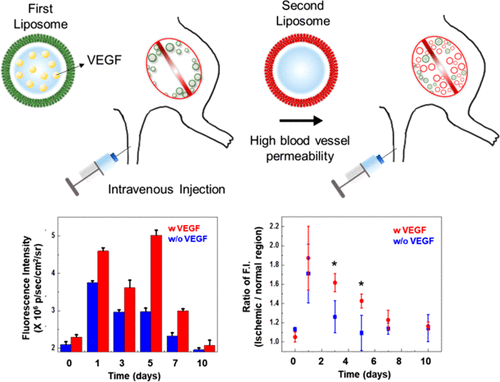当前位置:
X-MOL 学术
›
ACS Biomater. Sci. Eng.
›
论文详情
Our official English website, www.x-mol.net, welcomes your
feedback! (Note: you will need to create a separate account there.)
Sequential Targeted Delivery of Liposomes to Ischemic Tissues by Controlling Blood Vessel Permeability
ACS Biomaterials Science & Engineering ( IF 5.4 ) Pub Date : 2018-01-24 00:00:00 , DOI: 10.1021/acsbiomaterials.7b00815 Myungjoo Nam 1 , Jangwook Lee 2 , Kuen Yong Lee 2 , Jaeyun Kim 1, 3, 4
ACS Biomaterials Science & Engineering ( IF 5.4 ) Pub Date : 2018-01-24 00:00:00 , DOI: 10.1021/acsbiomaterials.7b00815 Myungjoo Nam 1 , Jangwook Lee 2 , Kuen Yong Lee 2 , Jaeyun Kim 1, 3, 4
Affiliation

|
Delivery systems for therapeutic angiogenesis that deliver angiogenic factors to ischemic tissues have recently been fabricated. However, these systems are designed for surgical implantation or multiple local injections which can cause pain and potential physical burden in patients. Here, we propose a minimally invasive sequential nanoparticle-mediated delivery strategy for ischemic tissue using a murine hindlimb ischemic model. Intravenously injected liposomes that encapsulate VEGF, an angiogenic factor, first target the ischemic sites via the enhanced permeability and retention (EPR) effect in early stages of ischemia. VEGF released from the targeted liposomes maintains the blood vessel permeability for a longer period of time compared to the delivery of empty liposomes. This first nanoparticle-mediated delivery of VEGF to the ischemic site enables extending the temporal window of leaky blood vessel up to 7 days so that the second liposomes could be targeted to the ischemic sites via EPR effect. This strategy will provide opportunities for the targeted delivery of other vessel maturation agents loaded in nanoparticles to ischemic tissue.
中文翻译:

通过控制血管渗透性将脂质体顺序靶向递送至缺血组织
最近已经制造了用于将血管生成因子递送至缺血组织的用于治疗性血管生成的递送系统。但是,这些系统设计用于手术植入或多次局部注射,这可能会导致患者疼痛和潜在的身体负担。在这里,我们提出了一种使用鼠后肢缺血模型的缺血组织的微创顺序纳米颗粒介导的递送策略。封装有血管生成因子VEGF的静脉注射脂质体首先在缺血的早期阶段通过增强的通透性和保留(EPR)效应靶向缺血部位。与空脂质体的递送相比,从靶向脂质体释放的VEGF在更长的时间内保持了血管通透性。首次将纳米颗粒介导的VEGF传递至缺血部位,使渗漏血管的时间窗延长了长达7天,因此第二个脂质体可通过EPR效应靶向缺血部位。该策略将为将负载在纳米颗粒中的其他血管成熟剂靶向递送至缺血组织提供机会。
更新日期:2018-01-24
中文翻译:

通过控制血管渗透性将脂质体顺序靶向递送至缺血组织
最近已经制造了用于将血管生成因子递送至缺血组织的用于治疗性血管生成的递送系统。但是,这些系统设计用于手术植入或多次局部注射,这可能会导致患者疼痛和潜在的身体负担。在这里,我们提出了一种使用鼠后肢缺血模型的缺血组织的微创顺序纳米颗粒介导的递送策略。封装有血管生成因子VEGF的静脉注射脂质体首先在缺血的早期阶段通过增强的通透性和保留(EPR)效应靶向缺血部位。与空脂质体的递送相比,从靶向脂质体释放的VEGF在更长的时间内保持了血管通透性。首次将纳米颗粒介导的VEGF传递至缺血部位,使渗漏血管的时间窗延长了长达7天,因此第二个脂质体可通过EPR效应靶向缺血部位。该策略将为将负载在纳米颗粒中的其他血管成熟剂靶向递送至缺血组织提供机会。










































 京公网安备 11010802027423号
京公网安备 11010802027423号